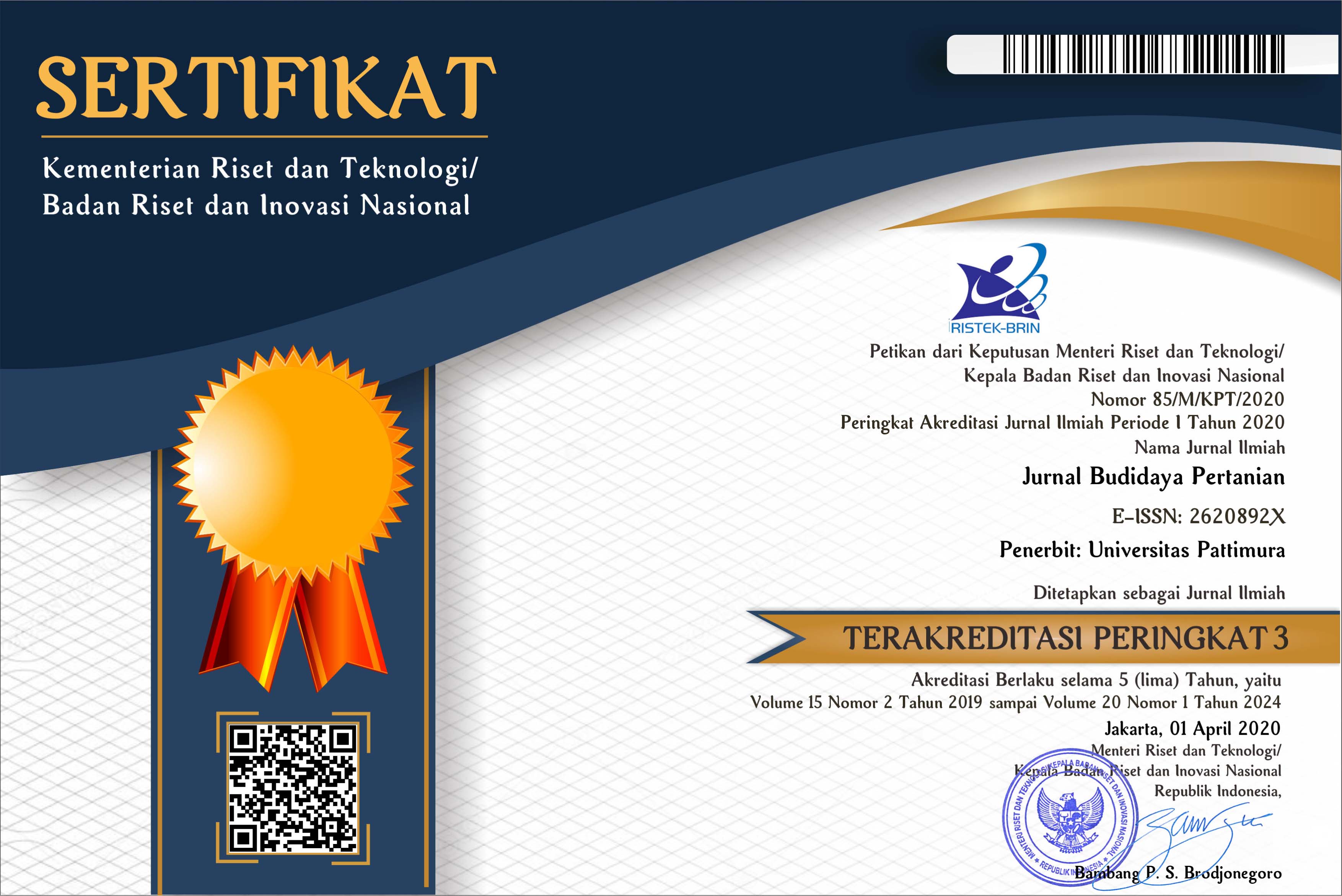PERTUMBUHAN AGENS HAYATI Trichoderma harzianum DENGAN BERBAGAI TINGKAT DOSIS PADA BEBERAPA JENIS KOMPOS
Abstract
This research was made in July to September 2016 in Plant Disease Laboratory, Agriculture Faculty, Pattimura University, Ambon. This research was made with purpose to get the best compost as a carrier of Trichoderma harzianum. The research method was experiment method using completely randomized program (RAL) using two factors, i.e three treatments with three repetitions, therefore 27 unit specimen were found. Based on observation in the laboratory, the result were: 1) a growth and best dense of T. harzianum spore in compost was in 10 % dose; 2) Compost produced by Farmers’ group Sumber Wiji Kairatu was the best for T. harzianum with pH grade of 7.5; and 3) Best compost formulation as a carrier for control agent T. harzianum was produced by Farmers’ group Sumber Wiji Kairatu with 10 % dose.
Downloads
References
Atlas, R.M. and R. Bartha. 1993. Microbial Ecology, Third Edition. Canada: The Benjamin/Cummings Publishing Company Inc.
Carlile, M.J. and S.C. Watkinson. 1994. The Fungi. San Diego: Academic Press.
Cook, R.J. dan H.K. Baker. 1983. The Nature and Practise of Biological Control of Plant Pathogens. American Phytopathological Society, St. Paul, Minnesota. 539 pp.
Djatmiko, H.A. dan S.S. Rohadi. 1997. Efektifitas Trichoderma harzianum hasil perbanyakan dalam sekam padi dan bekatul terhadap patogenesitas Plasmodiophora brassicae pada tanah latosol dan andosol. Majalah Ilmiah UNSOED 2: 10-22.
Handayanto, E. dan K. Hairiah. 2007. Biologi Tanah Landasan Pengelolaan Tanah Sehat. Yogyakarta: Pustaka Adipura.
Kalay, A.M. dan A. Talahaturuson. 2014. Perbanyakan Trichoderma harzianum pada media berbasis ela sagu. Jurnal Agroekoteknologi 6: 105-113.
Kelley, W.D. 1977. Interactions of Phytophthora cinnamomi and Trichoderma spp. in relation to propagule production in soil cultures at 26 degrees C1. Canadian Journal of Microbiology 23: 288-294.
Kredics, L., Z. Antal, L. Manczinger, A. Szekeres, F. Kevei, and E. Nagy. 2003. Influence of environmental parameters on Trichoderma strains with biocontrol potential. Food Technology and Biotechnology 41: 37-42.
Lilik, R., B.S. Wibowo, dan C. Irwan. 2010. Pemanfaatan Agens Antagonis Dalam Pengendalian Penyakit Tanaman Pangan dan Hortikultura. http://www.bbopt.litbang.deptan.go.id Akses 10 April 2016.
Munawar, A. 2011. Kesuburan Tanah dan Nutrisi Tanaman. Bogor: IPB Press.
Rifai, M., S. Mujim, dan T.N. Aeny. 1996. Pengaruh lama investasi Trichoderma viride terhadap intensitas serangan Phytium sp. pada Kedelai. Jurnal Penelitian Pertama 7: 20-25.
Samingan. 2009. Suksesi Fungi dan Dekomposisi Serasah Daun Acacia Mangium Willd dalam Kaitan dengan Keberadaan Ganoderma dan Trichoderma di Lantai Hutan Akasia. Disertasi. Bogor, Sekolah Pascasarjana Institut Pertanian Bogor.
Samuels, G.J., P. Chaverri, D.F. Farr, and E. B. McCray. 2010. Trichoderma Online, Systematic Mycology and Microbiology Laboratory, ARS, USDA.
Schmidt, O. 2006. Wood and Tree Fungi, Biology, damage, Protection and Use, Springe.
Suriawiria, U. 2006. Budidaya Jamur Tiram. Yogyakarta : Kanisus.
Syahni dan T. Thamrin. 2011. Potensi Pemanfaatan Cendawan Trichoderma spp. Sebagai Agens Pengendali Penyakit Tanaman Di Lahan Rawa Lebak. Balai Pengkajian Teknologi Pertanaian (BPTP) Sumatera Selatan. Palembang
Tindaon, H. 2008. Pengaruh Jamur Antagonis Trichoderma harzianum dan Pupuk Organik Untuk Mengendalikan Patogen Tular Tanah Sclerotium rolfsii Pada Tanaman Kedelai di Rumah Kaca. (Skripsi) Medan Universitas Sumatera Utara.
Yuwono, T. 2006. Kecepatan dekomposisi dan kualitas kompos sampah organik. Jurnal Inovasi Pertanian 4: 116-123.

 Accreditation is valid for 5 years, starting from Volume 15 Issues 2 December 2019 up to Volume 20 Issue 1 June 2024.
Accreditation is valid for 5 years, starting from Volume 15 Issues 2 December 2019 up to Volume 20 Issue 1 June 2024.






